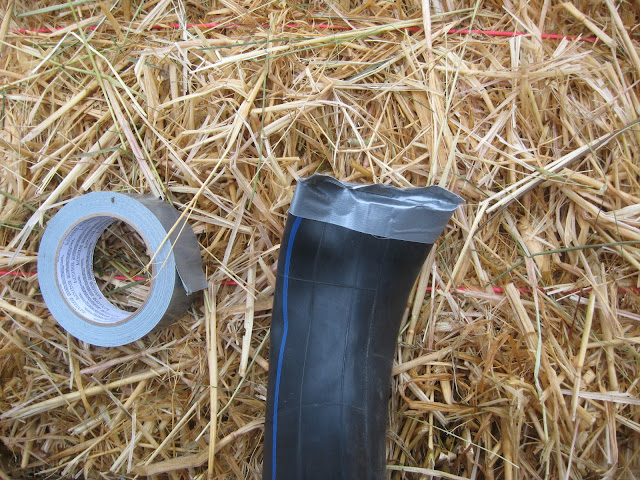The best place to find a tube is at a tire shop that deals with farm machinery. Don't bother with auto stores or car tire shops, they are likely to look at you as if you had just sprouted horns. If there are no farm shops who will give you old tubes for free, check Tractor Supply, they sell what you need. Look for a tube that has a diameter a couple of inches larger than the foot you are protecting. It is better to be a little too big then too small.
I have found that used tubes actually work a bit better then new ones as they are more pliable and "broken in" already. If you have to buy a new tube, it would help if you fill it with air over night, at least, to stretch it out. If you can't, don't worry, it still works, the rubber is just a little stiffer is all.
The tube I am using on Ramsey is for a wheel barrow or snow blower. It has a four inch diameter and is made for an eight inch rim. Motorcycle tubes are also an option for smallish animals. A bicycle tube would work for a very small animal. A front tractor tire tube would most likely fit an average sized horse and a rear tractor tube would be right for that elephant.
To make a muck boot: first, cut the valve stem off and then cut the tube in half so that you have a length of tube open at both ends.
Use duct tape to seal one end. Don't put it on too heavy at this point or the boot won't be flexible enough to conform to the hoof. You will need to add a lot more tape later, but if you do it at this stage, you won't be able to shape it to the foot and it is not likely to fit well.
At this point, slide the tube over the foot with the curve of the tube following the curve of the leg. Depending on the size of the foot you are dealing with, it may be helpful to put a slit in the top of the boot so that it will go on and off easier and fit the leg better. Once in place, you will need to wrap the business end with more tape to seal and shape it. I fold the front of the tube up, curve the corners up and in and wrap with more tape. Use the tape to shape the foot portion, just don't make it too tight or you will have to cut it to remove it.
(It is good to have more than one of these so that if one gets wet, you can switch off.)
If conditions are wet, I put a rubber glove over Ramsey's foot first....
followed by a plastic baggie. This adds to the waterproofing and makes the tube easier to slip on and off. It's like a sock. A shopping bag would work for larger beasties.
Once the boot is on, you will need to add a piece of tape around the pastern to keep it on as well as a piece around the cannon bone to keep snow and debris out.
Depending on the weather, the bottom hoof-wrap portion generally holds up for about a week. Less in wet weather and more if dry. I may add a bit more tape throughout the week as reinforcement. I try to make the tape on the bottom of his foot crinkle up some rather then be smooth as it helps provide some traction on slippery ground. The tape around his pastern and cannon bones gets replaced every time I use the boot so you will go through a lot of tape. Go ahead and buy the cheap stuff, it works just as well for this as the higher quality, expensive stuff.
As with all muck boots, this boot is a bit cumbersome and it is not breathable, but it does not hinder or bother Ramsey. The boot can't be left on for more than a few hours at a time since it does not breath. However, it allows Ramsey to have some freedom and exercise no matter the weather. He gets to spend 2-3 hours a day out with mom and I take him for short walks at least twice a day. It has gone a long way towards helping him heal, both physically and mentally.












Thank you for this post. I was wondering how you made his boots.
ReplyDeleteINGENIOUS!
He is looking so good.... I gotta get over and say hello to him! DRR
ReplyDeleteI'm going to go with "Pure Genius"
ReplyDelete
ReplyDeleteYou are a superhero.
This is a total genius idea and invention...you should Patent it!
ReplyDeleteThis is brilliant, Kris!
ReplyDeleteThis is brilliant, Kris!
ReplyDeleteWhere is the like button :)
ReplyDeletePriscilla